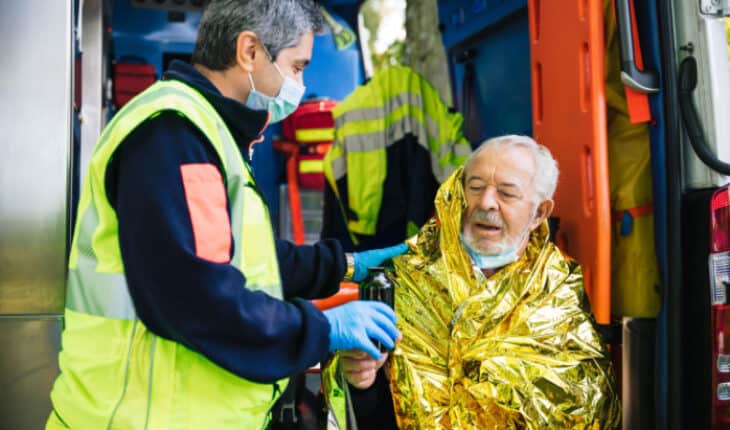Hypothermia
Hypothermia is defined as the point at which the core body temperature falls below 35°C.
Small children and babies are particularly at risk as their temperature control area in the brain is not always fully developed. Elderly people are also more likely to suffer from hypothermia. Anyone out in cold conditions with insufficient warm clothing they can quickly develop mild hypothermia.
Cold water and wet clothing brings body temperature down very fast. People with high levels of alcohol or drugs in their system find it harder to maintain their body temperature. Therefore if someone has collapsed outside a pub during the festive season, hypothermia is a very real threat.
People falling or collapsing in cold temperatures can quickly develop serious hypothermia if they are not discovered and treated quickly.
Signs and symptoms
- Pale, quiet and cold to touch.
- They may be shivery and then stiff with cold.
- Blue lips
- As hypothermia develops further, they become confused, disorientated and may lose consciousness – severe hypothermia kills.
- Their heart rate and breathing rate may slow.
- The body uses up glucose reserves trying to keep warm and so the blood sugar drops.
- Hypothermia affects the blood’s ability to clot and also impacts the heart.
- People experiencing prolongues hypothermia may experience cardiac arrythmias and this can lead to cardiac arrest.
- Babies may be pale and drowsy and off their food.
Treatment
- Remove cold, wet clothing.
- Put on warm dry clothing.
- Cover their head as well.
- Wrap them up in coats and blankets, increase the room temperature if possible as well.
- If you are unable to get indoors, wrap them in a foil blanket and use a survival bag and shelter if possible.
- Give them warm (non-alcoholic) drinks.
- Always seek medical advice. If their condition deteriorates phone the emergency services.
You are aiming to warm the core of their body, warming them slowly from within. Do not initiate any rapid changes.
Do not use hot water bottles or put the person in a bath to warm them. This can warm them too quickly and warms their periphery rather than their core. It can also lead to burns.
If they lose consciousness and are breathing put them in the recovery position.
If they stop breathing do CPR.
NOTE: if they are very cold, keep them still as the extreme cold can affect their heart and any swift movement could cause a cardiac arrest.
Common causes of hypothermia:
Older people falling at home is one of the most common causes of hypothermia. If they are unable to get help, they may lie for long periods undiscovered in the cold. In a particularly cold spell in January 2023, with the ambulance service struggling with response times, the Scottish ambulance service reported that they were taking 44 people a day to hospital experiencing hypothermia. Sadly many of the other UK ambulance services have also been treating more people than usual with hypothermia.
Alcohol affects the body’s ability to maintain body temperature and so it is vital that anyone who has collapsed from alcohol is kept warm and dry to avoid them suffering from hypothermia.
The cost of living crisis has also led to many more cases of hypothermia, with people avoiding using heating, or only heating one room. Ideally your house should be 18 degrees C. If you are reducing your heating, it is vital to wear sufficient layers of warm clothes and always cover your head.
For people who have been playing sport and are injured, it is really important that they are kept warm. They should sit on something to insulate themselves from the ground and it may be sensible to wrap them in a reflective blanket to retain their body heat and avoid them getting cold.
Frostbite
Frostbite happens when an extremity (such as a finger, toe or ear) gets so cold that ice crystals form in the cells and destroy them.
The casualty may develop pins and needles, tingling and then numbness in the affected area.
The skin becomes hard and changes first to white, then blue and finally turns black as the cells die.
As the area is warmed it can become hot, red and very painful.
Treatment
Carefully remove jewellery if possible – they may need to be cut off.
Do not rub the injury as this will make things worse. To stop the freezing getting worse, cup the affected area in your hands. Do not start to warm them if there is a danger of the area re-freezing. Move them indoors and start to warm them slowly by placing the affected area in warm water. Refer for medical help as soon as possible.
Related conditions
Chilblains: happen as a result of dry cold. The cells do not freeze but the extremities become itchy, bluish-red in colour and swollen. If it is not treated the casualty may develop blisters. Treatment is the same as for frostbite.
Trench foot: caused by prolonged exposure to wet and cold conditions. The cells do not freeze but the signs and symptoms are similar to frostbite.
- What is a seizure? - 13th March 2025
- Febrile Convulsions and Seizures in Children - 13th March 2025
- Why women are less likely to receive CPR or survive cardiac arrest - 6th March 2025








